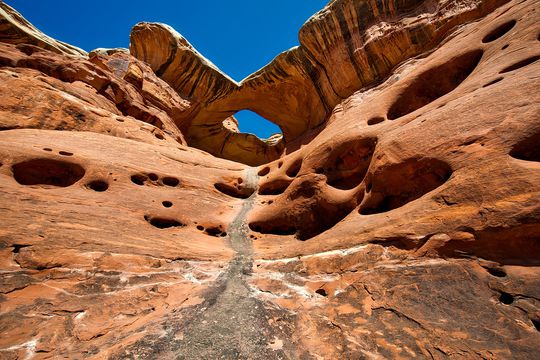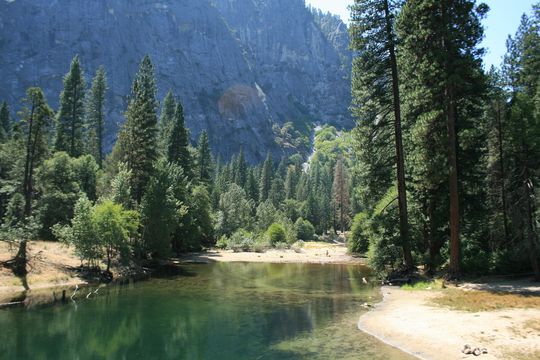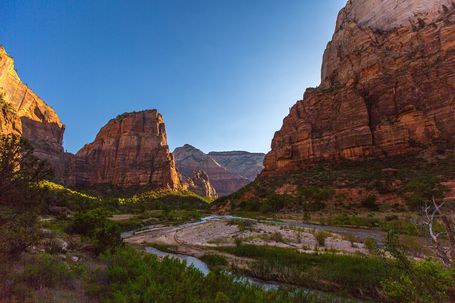When someone says National Parks and Utah you most likely think of national parks like Arches, Canyonlands, Bryce, Zion and perhaps even Capitol Reef. Did you know that southern Utah has six other national park units celebrating some of the best cultural and natural wonders in the state?
In the fall of 2014 I made it my goal along with my parents to visit all the park units in Southern Utah to enjoy the diversity of landscapes and cultures the National Park System and other federal agencies protect in the region. We joined a guided tour for the first part which focused on Arches and Canyonlands which you may know has set records for visitation in the last few years which may result in a reservation system to enter the park. The advantage of being with a group is that our guides know many of the secret spots in the park and when to go to them to minimize interaction with the crowds. A prime example is once we arrived to Moab, the gateway town for both parks, instead of heading into Arches during the busiest time for visitors we instead continued a bit farther west to the northern entrance of Canyonlands and the Island of the Sky District. Views don’t get much better than this region of the park which allows you to look south and follow the path of the Colorado River as it winds its way through the park. On our way back to Moab we ducked into Arches as the crowds had decreased with late afternoon arriving. This provides a great opportunity to drive the 16 mile road in the park and get an overview from our guides of the many rock formations the park protects and that we would be taking a closer look at the next morning.
Getting an early start is key to beat the morning rush in Arches. With just a few hours you can work your way from the northern end of the park and walk amongst the arches in the famous Devil’s Garden to taking a stroll out to Delicate Arch where the sheer size of the arch makes everyone look like ants to enjoying a loop hike in the Windows section of the park where you can sit under one of the windows and enjoy the warmth of the sun all before the parking lots and trails begin to fill up. Another benefit to an early start is it gives you time to explore outside the park in neighboring land protected by Bureau of Land Management (BLM) where we tried our hand at canyoneering. Now for someone like me who is not a big fan of heights strapping on a harness and rappelling down into a slot canyon where I cannot see the bottom was a frightening but in the end one of the most amazing experiences I have ever done. It was made even better when you exit the canyon in a slot not much wider than your whole body and it instantly opens into a vista farther than the eye can see. Just when I thought the day couldn’t get any better we rappelled right under a huge arch where once again you feel the magnitude of the landscape around you and realize we each are just one small part of a much larger planet.
We had seen Canyonlands from above but now it was time to get down to the ground level and go to the Needles District of the park. On your way into the eastern entrance of Canyonlands make sure you stop off at Newspaper Rock State Historic Monument in one of our nation’s newest national monuments, Bears Ears, where you can see one of the largest collections of petroglyphs in the country dating back over 2,000 years. As you drive deeper into the park you will be welcomed by cliff walls that give you a true sense of where the park gets its name of Canyonlands because as far as your eye you can see you will see one canyon after another.
After saying farewell to our guides and our group it was time to explore some of Utah’s lesser known parks starting with Hovenweep National Monument. The park transports you back in time to the home of over 2,500 people who lived in the area from A.D. 1200-1300. You can walk amongst historic structures on a short mostly paved loop trail including homes, storage towers, and see buildings built right into the side of the canyon. Although technically across the border in Colorado we stopped at Canyons of the Ancients, protected by BLM, to learn even more about the people that lived in this region for over 10,000 years. Visiting both sites give you a true sense of the region and the hardships the Puebloan people had to endure to survive in the area.
Back in 2014 our drive west from here was not yet part of Bears Ears National Monument but if you follow highway 95 today you will be treated to a fantastic landscape which is one of the reasons this land is now protected by the National Park Service. Unfortunately, that protection is now under threat as the monument may be reduced or broken up which would still leave it under federal protection under the BLM, but under less strict regulations which may impact this vital area by allowing mining or drilling. Just off of highway 95 is another hidden gem, Natural Bridges National Monument, where you will be welcomed by a large array of solar panels, as the park completely runs off of renewable energy. A perfect spot for lunch if the timing works out for your trip as you can walk to the bottom of the canyon and enjoy your lunch under a huge natural bridge and ponder the power of water which carved the bridge and the two other bridges in the park. We only spent a couple hours doing the scenic 9-mile drive and some short hikes, but the park left a deep impression on me as it was an important reminder of the power of nature.
Even though you may be tempted to take an afternoon nap in the car on your way north on highway 95 to Capitol Reef I would recommend keep your eyes open because the landscape just keeps getting better and better. You wind your way up to the Colorado River and the northern section of Glen Canyon National Recreation Area while being surrounded by red rock canyon walls until you cross the river to make a stop at the Hite Overlook to get a great view of the Colorado in both directions.
After a couple more hours of eye-popping views you will enter the eastern side of Capitol Reef National Park home to largest waterpocket fold in the country and in my opinion a park that perfectly blends nature and culture into one. You can go for hikes through slot canyons, explore a living homestead with an active orchard, go on one of many scenic drives, or check out a pioneer registry of names carved right into a rock wall. Spending at least half a day here is the bare minimum as you could spend many days if not a whole week finding all the secret spots in this park.
If the scenery in Utah has blown you away so far just wait until you drive south from Capitol Reef along scenic highway 12 making your way from 6,000 feet to nearly 10,000 feet. Since we were traveling in September as we gained elevation the fall colors kept getting better and better making the drive even more spectacular and hard to resist stopping at every overlook to take photos. As you are coming back down from the peak just past the town of Boulder, UT, in Grand Staircase-Escalante, stop off and hike either the Upper or Lower Calf Creek falls trail. The Lower falls trail is fairly flat and leads right to the base of the falls which is a true oasis in the surrounding desert landscape and makes for some fantastic photos. After a full day of fantastic exploration, you will see a left turn off of Highway 12 into your next national park, Bryce.
I have never visited a place quite like Bryce and its larger-than-life amphitheater full of hoodoos as far as you can see. Walking the rim trail right from the lodge as the sun is setting is a once-in-a-lifetime type experience with the hoodoos glowing in the last glimmers of the sun light giving you a sense of how special this place is. Depending on how adventurous you are a number of trails from 2 to 10 miles round-trip will take you down into the canyon to get a closer look at famous structures like Thors Hammer, Queen’s Garden, and Wall Street. You will see how they are carved by freezing and thawing but also unfortunately more recently by acid rain making some look more like mushrooms than hoodoos. Each formation has its own personality and it is fun to see how each person interprets what they look like, similar to what we often do with clouds.
Often left out of trips that people plan when going to Bryce and Zion is Cedar Breaks National Monument. At just over 11,000 feet depending on the time of year you visit you may be welcomed by over 150 species of wildflowers, fantastic fall colors or on my most recent visit there was a few inches of snow. Similar to Bryce the park features a huge amphitheater of hoodoos, but here the canyon is 2,500 feet deep which you can view from a trail that follows the rim of the amphitheater and even though the trail is only 4 miles round-trip it can feel like a lot more because you are so high up.
Capping off a fantastic Utah journey is Zion National Park where like Capitol Reef you can spend a few hours, a few days, or over a week exploring all the park has to offer. One of my favorite parts is that no cars are allowed in most of the park and instead you get around by a free shuttle or by renting a bike. Hikes range from easy trails that take you along the Virgin River, to visiting the Emerald Pools, or below Weeping Rock. Even if you don’t feel like taking on the famed Narrows (although the walk through the Virgin River is quite epic) make sure to at least do the Riverside Walk trail to the beginning of the Narrows to get a sense of how grand Zion Canyon is. For those really wanting an adventure head up to Angel’s Landing where you can take on your fear of heights by using chains to assist you to the top. As mentioned before I do not like heights, so I made it to the first section of chains and then waited for my friends as the views were quite enough for me even there. A great way to either start or end your visit to Zion is the Watchman Trail with outstanding views of the canyon and a trail that almost everyone can hike with a gentle uphill to the viewpoint. Don’t forget that Zion has two sections and visiting Kolob Canyon will allow you to get away from the crowds and see a completely different side of the park with red walls surrounding you and views of Zion and beyond from above.
Southern Utah is definitely a place you will need to visit more than once in your life but spending 10-14 days seeing the Mighty Five and also checking out the six other national park sites the region offers will be a journey you will be remember forever. Black Sheep Adventures offers an eight-day tour that includes all these parks except Arches and Canyonlands. Hope you can join us soon to explore this fantastic part of our country.








